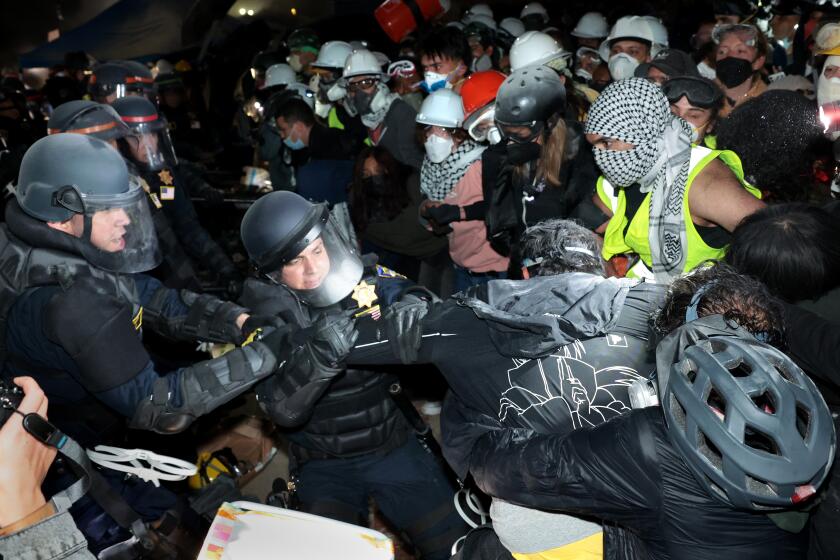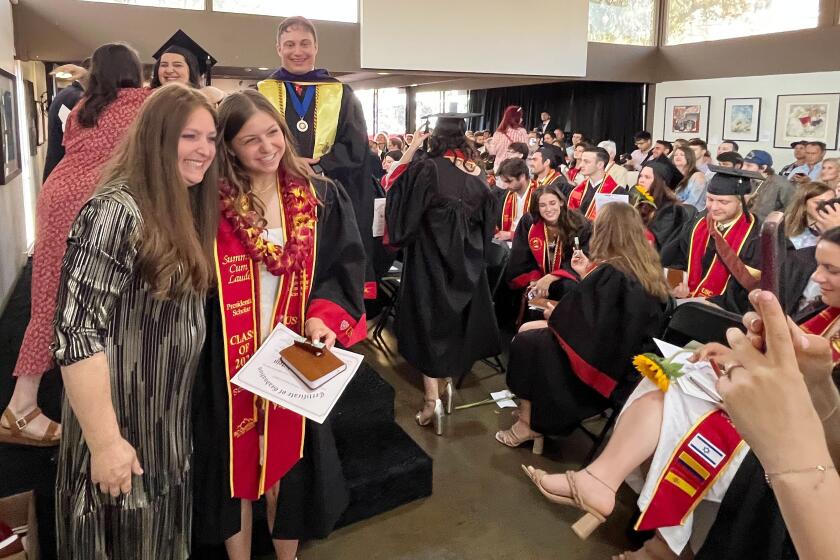Enrollment Soars in L.A. Unified
Two years after expanding its library, Heliotrope Avenue School is having to carve out some of that cherished space to create another classroom as the Maywood campus continues to grow out of its skin.
“It’s very tight around here,” Principal Ray Fisher said. “We didn’t anticipate the numbers of kids coming to the front counter to enroll this year. The library has our last available space for them.”
Heliotrope is not alone. Los Angeles Unified School District officials on Wednesday announced that their demographers significantly underestimated this year’s enrollment. Kindergarten through 12th-grade enrollment jumped 2.3% from last year--an increase of 15,592 and about 6,000 more than anticipated.
The student population is now 697,097.
The latest count is bad news for district officials already nervous about forecasts that the student body will grow by 80,000 over the next decade, and is additional evidence to support their call for new schools.
“The urgency of our need for new schools and sufficient classroom space cannot be more evident,” said L.A. Unified Supt. Ruben Zacarias. “These numbers make it imperative that the public support our efforts to locate convenient sites and build more schools.”
The district has experienced an increase of 60,000 students over the past four years--nearly equal to the student body of San Francisco Unified.
Most of the growth has been in Central, South-Central, the area east of downtown and parts of the San Fernando Valley.
An estimated 13,000 students ride buses to schools with less and less room to seat them. Some of those rides take 90 minutes.
“We do have a master plan for building,” said school board President Victoria Castro. “But until those schools and rooms are actually in place and ready to receive students, the number of young people riding buses to relieve overcrowding is only going to grow. It’s regrettable, but it’s a fact.
The squeeze is so tight at Cahuenga Elementary School that 1,575 students spend hours each day riding buses to a shrinking number of other sites.
“Many of our families are new to this country, and they have a hard time understanding why their kids can’t go to their local school,” said Principal Lloyd Houske. “Yet when a new child comes in, we often have to call 25 other schools in search of available space.”
The school resembles a mid-city transportation hub with dozens of parents herding hundreds of students on and off a steady stream of buses.
Waiting for the arrival of her 10-year-old daughter, Natahly, who is bused each day from Cahuenga to Encino, Guadalupe Hernandez said, “This is just not right.”
“We have to build more schools in this area for people who live nearby--we only live two blocks away,” she said. “Natahly’s been taking the bus for three years.”
At Langdon Avenue Elementary School in the North Hills area of the Valley, space is so limited that school psychologists are reduced to counseling students in a stuffy storage room slightly larger than a closet. Langdon Principal Robert Albin, whose school enrolled about 1,600 students this fall, said he asked for two bungalows to accommodate his exploding student population, but relief has not arrived.
“We’ve got classes in the library, we’ve got classes in the auditorium. We’re so crowded in here we can’t even see straight,” Albin said.
As it stands, 82 schools are filled to capacity on their current operating calendars, and 125 other schools, now within 3% of their capacity, will probably be filled next year, according to Assistant Supt. Gordon Wohlers.
In response to this crunch, the school board has approved a $1.82-billion master plan that recommends the construction of 51 new schools: nine high schools, five middle schools, 13 elementary schools, 20 primary centers and four continuation high schools.
District officials propose paying for the construction with funds from Proposition BB, which was passed by voters in 1997, and the $9.2-billion state school bond measure on the Nov. 3 ballot, Proposition 1A.
If the schools are not built, as many as 79,000 students would need to be bused by the year 2008--provided seats could be found at other district schools.
“It would mean many, many more traveling students, schools receiving many more children, adding many more portable classrooms, and changing many more calendars to year-round schedules,” Wohlers said.
Times staff writer Margaret Ramirez contributed to this story.
More to Read
Start your day right
Sign up for Essential California for news, features and recommendations from the L.A. Times and beyond in your inbox six days a week.
You may occasionally receive promotional content from the Los Angeles Times.







